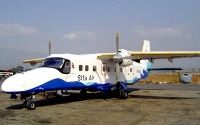
Nepalese aviation officials and executives of Sita Air are at odds over what brought down a Sita Dornier 228 Friday in Katmandu, killing all 16 passengers and three crew. It may be up to British investigators to sort out just what happened. The twin had just taken off from Katmandu’s airport headed for Lukla, the first stop for many Mt. Everest trekkers, when the pilot reported a bird strike. Witnesses on the ground reported seeing the aircraft on fire before it crashed on an open patch of ground in the middle of the city. The aircraft burned after impact and the only recognizable part left was the tail. There seems to be agreement that the aircraft hit a bird, possibly a vulture, but that’s where the airline and the government diverge.
Suresh Acharya, a senior aviation official, told reporters the aircraft was seen doing “unusual maneuvers” prior to the crash and suggested pilot error was the primary cause. “But a plane crash does not occur simply just because its engine was hit by a bird,” he is reported by BBC to have said. “The pilot may have been panic-stricken [and] made a steep narrow turn instead of forming a wider radius required to bring the malfunctioning aircraft back to the runway.” Airline spokesman Deependra Shahi responded that his information suggested the bird strike caused the engine to catch fire. Meanwhile, British officials have been reported saying the aircraft may have been overloaded with passengers and gear and might not have been able to make the turn back to the airport on one engine. The aircraft has 19 passenger seats and a maximum payload of more than 5,000 pounds. Katmandu’s elevation is about 4,400 feet above sea level and the temperature at the time of the crash was about 70 degrees.

































